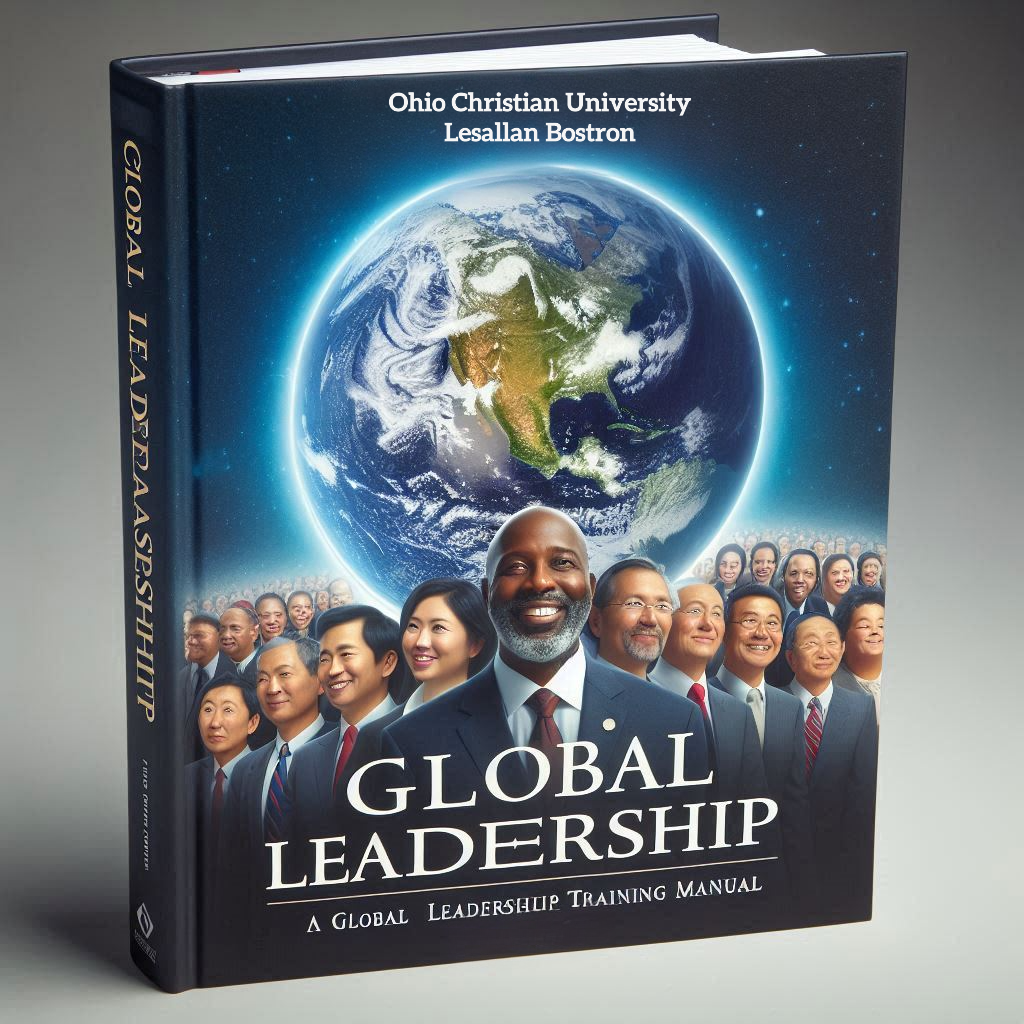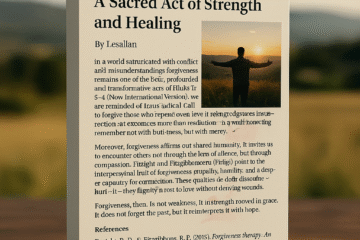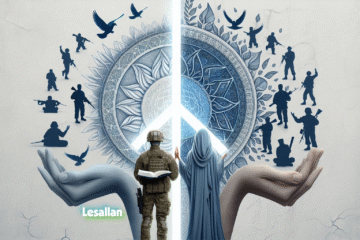A Global Leadership Training Manual
Written by Lesallan Bostron – November 1, 2024
Ohio Christian University
LDR4100 Global Leadership (ONL24F1)
Dr. Durrel Parker

Global Leadership: The Essentials
A Global Leadership Training Manual
Table of Contents
Preface
The current global landscape is characterized by significant complexity and interconnectivity, necessitating a new generation of leaders who are not only highly skilled but also adaptable and culturally aware. In this ever-evolving environment, effective global leadership has never been more crucial. This training manual, titled “Global Leadership Essentials,” is designed to equip aspiring leaders with the knowledge and tools they need to navigate the dynamic global arena successfully and ensure their future success.
This manual serves as a comprehensive guide, drawing on the latest research and practical insights to help develop core competencies essential for global leadership. From cultivating cultural intelligence to strategic thinking and adaptability, each section offers valuable frameworks and strategies to enhance leadership capabilities (Mendenhall et al., 2018).
The content is thoughtfully structured to provide a logical flow, beginning with an overview of the importance of global leadership and progressing through critical areas of focus. Each section is enriched with real-world examples, case studies, and practical applications, ensuring that the principles discussed are theoretical, grounded in reality, and easily applicable. This sensible approach will give you the confidence to apply your new knowledge in real-life situations.
By leveraging insights from renowned sources such as Mendenhall et al. (2018) “Global Leadership: Research, Practice, and Development” and incorporating multimedia resources from industry experts (GreggU, 2021; Hu-Chan, 2015; Heidrick & Struggles, 2015), this manual aims to be both informative and engaging. It is designed to impart knowledge and inspire and motivate current and future leaders to strive for excellence in their global leadership journey.
As we embark on this global leadership exploration, I encourage you to approach each section with an open mind and a willingness to learn. The journey toward becoming an effective global leader is continuous, and this manual is intended to be a valuable companion along the way. Remember, your commitment to continuous learning and growth will set you apart as a global leader.
References:
Apple. (2024). Apple. Apple. https://www.apple.com/
GreggU. (2016). What is Talent Management?
GreggU. (2021). Developing Global Leadership Competencies. YouTube.
Heidrick & Struggles. (2015). LeadershipTV® – What Makes a Global Leader?
Hu-Chan, M. (2015). Five Core Competencies for Global Leaders. YouTube.
King James Bible. (2020). OFFICIAL KING JAMES BIBLE ONLINE: AUTHORIZED KING
JAMES VERSION (KJV). https://www.kingjamesbibleonline.org/
Martin, M. (2009). Developing Global Mindset and the Impact on Virtual Teams.
Mendenhall, M. E., Osland, J., Bird, A., Oddou, G. R., Stevens, M. J., Maznevski, M. L.,
Stahl, G. K., & Routledge. (2018). Global leadership: Research, practice, and development. Routledge Taylor & Francis Group.
One Young World. (2016). Leading global change: Ambassadors in Action 2016.
Acknowledgments
This manual, “Global Leadership Essentials,” is the culmination of insights and expertise from various esteemed sources. First and foremost, I would like to extend my deepest gratitude to Dr. Durrel Parker, whose guidance and support throughout this course have been invaluable.
I would also like to say thank you to the following:
- Mendenhall, M. E., Osland, J., Bird, A., Oddou, G. R., Stevens, M. J., Maznevski, M. L., Stahl, G. K., & Routledge for their comprehensive text, Global Leadership: Research, Practice, and Development, which provided the foundational framework for this manual.
- A special thanks to GreggU for their insightful YouTube videos, “What is Talent Management” (2016) and “Developing Global Leadership Competencies” (2021), which offered practical strategies and valuable perspectives that enriched this manual.
- The leadership insights from Heidrick & Struggles’ “What Makes a Global Leader?” (2015) and Hu-Chan’s “Five Core Competencies for Global Leaders” (2015) have been particularly influential and greatly appreciated.
- I am also grateful to the creators of King James Bible Online (2020) and Bible Gateway (2011) for providing scriptural insights, which added a profound depth to the leadership principles discussed.
- Additionally, my appreciation extends to Martin, M. (2009) for their paper on developing a global mindset and its impact on virtual teams and to One Young World for their inspiring video, “Leading Global Change: Ambassadors in Action 2016” (2016).
- Lastly, a heartfelt thank you to Apple (2024) for its innovative leadership model, which continues to set a standard in global excellence.
Thank you all for your contributions and for fostering a deeper understanding of global leadership.
Contributors
Mendenhall, M. E., Osland, J., Bird, A., Oddou, G. R., Stevens, M. J., Maznevski, M. L., Stahl, G. K., & Routledge for their comprehensive text, Global Leadership: Research, Practice, and Development.
GreggU for their insightful YouTube videos: “What is Talent Management” (2016) and “Developing Global Leadership Competencies” (2021).
Heidrick & Struggles for their video, “What Makes a Global Leader?” (2015).
Hu-Chan, M. for the video, “Five Core Competencies for Global Leaders” (2015).
Creators of the King James Bible Online (2020) and Bible Gateway (2011) for providing scriptural insights.
Martin, M. for the paper on developing a global mindset and its impact on virtual teams (2009).
One Young World for their inspiring video, “Leading Global Change: Ambassadors in Action 2016” (2016).
Apple (2024) for its innovative leadership model.
Introduction
The sections below provide an overview of global leadership’s importance and the manual’s objectives. They discuss the global economy’s increasing complexity and the need for skilled, adaptable, and culturally astute leaders.
Developing Cultural Intelligence
Concept of Cultural Intelligence: Cultural intelligence (CQ) refers to the ability to relate and work effectively across cultures. It is a crucial competency for global leaders as it enables them to navigate cultural differences, build stronger relationships, and foster inclusive environments. CQ helps leaders to understand and respect different cultural perspectives, which is essential for effective global leadership.
Key Components:
- Cognitive: This involves knowledge about different cultures, including their values, beliefs, and social norms. It is the intellectual understanding of cultural differences.
- Emotional (Motivational): This component pertains to the leader’s interest and confidence in functioning effectively in culturally diverse settings. It is about the drive to adapt and learn from other cultures.
- Physical (Behavioral): This includes adjusting one’s behavior to different cultural contexts. It encompasses verbal and non-verbal actions that facilitate effective cross-cultural interactions.
- Practical Strategies: Self-Awareness: Leaders should start by understanding their cultural biases and how they may affect their interactions with others.
- Education and Training: Engaging in formal education and training programs on cultural awareness and intercultural communication.
- Exposure and Experience: Actively seeking out and participating in multicultural environments, such as working on international projects or living abroad.
- Mentorship and Coaching: Learning from mentors with strong cross-cultural experience can provide valuable insights and guidance.
- References and Examples: Insights from GreggU’s “Developing Global Leadership Competencies” (2021) highlight the importance of developing cultural intelligence to manage diverse teams effectively. Similarly, Hu-Chan’s “Five Core Competencies for Global Leaders” (2015) emphasizes the significance of emotional and behavioral adaptability in achieving successful leadership outcomes in global contexts.
Strategic Thinking in Global Leadership
Strategic thinking involves anticipating, envisioning, maintaining flexibility, and empowering others to create strategic change. It is crucial for global leaders as it allows them to navigate complex and dynamic environments, make informed decisions, and create sustainable competitive advantages.
Skills Development: Developing strategic thinking skills involves:
- Visionary Thinking: Cultivating the ability to see the big picture and long-term possibilities.
- Analytical Skills: Enhancing skills to analyze trends, data, and market dynamics.
- Critical Thinking: Sharpening the ability to challenge assumptions and think creatively.
- Decision-Making: Improving decision-making processes under uncertainty.
- Adaptability: Learning to remain flexible and open to new information and perspectives.
Tools and Frameworks
- SWOT Analysis: Identifies strengths, weaknesses, opportunities, and threats to understand internal and external environments.
- PESTLE Analysis: Examines political, economic, social, technological, legal, and environmental factors to evaluate the macro environment.
- Scenario Planning: Develop multiple plausible future scenarios to prepare for uncertainties.
References: Mendenhall, M. E., Osland, J., Bird, A., Oddou, G. R., Stevens, M. J., Maznevski, M. L., Stahl, G. K., & Routledge. (2018). Global Leadership: Research, Practice, and Development. Routledge Taylor & Francis Group.
Adaptability and Flexibility
Definition and Significance: Adaptability refers to the ability to adjust one’s approach or behavior in response to new and evolving circumstances. Flexibility is the capacity to remain open to change and to modify one’s mindset and strategies accordingly. These traits are essential in global leadership as leaders encounter diverse cultural, economic, and political environments. Influential global leaders can pivot quickly, embrace new ideas, and steer their teams through change and uncertainty.
Techniques to Improve
- Mindfulness: Practicing mindfulness can help leaders stay present and manage stress, improving their ability to respond to change calmly and effectively.
- Learning Agility: Continuously seeking new knowledge and experiences can enhance a leader’s adaptability. This involves being open to learning from mistakes and staying curious about different perspectives.
- Resilience Training: Building resilience helps leaders bounce back from setbacks. Techniques such as developing a positive outlook, setting realistic goals, and maintaining strong support networks are crucial.
Case Studies
- Heidrick & Struggles’ “What Makes a Global Leader?” (2015): Several global leaders shared their experiences navigating complex international markets in this resource. One leader described how adopting flexible strategies during a market downturn allowed their company to survive and thrive by diversifying product offerings and entering new markets.
- Anecdotes from My Own Experiences: I once worked with a leader who spearheaded a global project involving teams from multiple countries. Despite numerous logistical and cultural challenges, their adaptability and flexibility were vital to the project’s success. They continuously adjusted their strategies based on team feedback and changing circumstances, leading to innovative solutions and more robust team cohesion.
References: Heidrick & Struggles. (2015). LeadershipTV® – What makes a global leader? YouTube. https://www.youtube.com/watch?v=_pMGJ9KJvBU
Case Studies and Examples
- Sunil Nayak—Sodexo: Sunil Nayak, former CEO of Sodexo India On-Site Services, became a more inclusive leader when he joined the global services firm’s executive committee. His leadership transformation involved working with a team of 15 executives from different nationalities and cultures, which required a more inclusive leadership style. This adaptability and cultural intelligence helped him become the CEO of Sodexo’s Corporate Services Asia-Pacific.
- Jack Ma – Alibaba: Jack Ma, the founder of Alibaba, is known for his cultural intelligence and strategic thinking. He successfully navigated the complexities of leading a global company within the confines of a Communist government in China. His ability to understand and adapt to different cultural contexts has made Alibaba a global leader in e-commerce.
- Starbucks International Strategy: Starbucks has successfully expanded its coffee culture globally by balancing a consistent global brand with local adaptations. Their strategic approach includes rigorous market research, cultural sensitivity, and strategic partnerships, allowing them to integrate into diverse international markets while retaining their core identity.
Application of Principles in Real-World Scenarios
- Cultural Intelligence: Leaders with high cultural intelligence can create an inclusive environment where employees from various backgrounds feel valued and can contribute their best. For example, Sunil Nayak’s inclusive leadership style at Sodexo ensured effective communication and collaboration among a diverse team.
- Strategic Thinking: Strategic thinking involves identifying and cultivating opportunities that enhance organizational value. Starbucks’ strategic approach to international expansion, including tailored market entry strategies and local customization, exemplifies this principle.
- Adaptability: Leadership adaptability is crucial for navigating uncertainties and changing environments. Jack Ma’s ability to adapt to different cultural contexts and regulatory environments has been key to Alibaba’s success.
In summary, “Global Leadership Essentials” has provided a comprehensive guide to navigating the complexities of global leadership. The manual began by highlighting the critical need for skilled, adaptable, and culturally aware leaders in an increasingly interconnected world. We explored the concept of cultural intelligence, emphasizing its importance for effective global leadership and offering practical strategies to develop it. Strategic thinking was another key focus, where we discussed the significance of anticipating and adapting to global trends and challenges. We also covered adaptability and flexibility, underscoring their essential roles in leading through uncertainty and change.
The manual incorporated insights from renowned sources and real-world examples to ground the theoretical principles in practical applications. As an aspiring global leader, this approach ensures you can confidently apply what you have learned in your professional journey.
The journey to becoming an effective global leader is ongoing. Continuous learning and development are paramount. By committing to lifelong learning, staying curious, and being open to new experiences, you will enhance your leadership capabilities and inspire and lead others more effectively in the dynamic global landscape.
Remember, the essence of global leadership lies in your ability to adapt, think strategically, and cultivate meaningful connections across cultures. As you progress, keep this manual as a valuable companion, guiding and inspiring you toward excellence in your leadership endeavors. Your commitment to growth will set you apart and ensure your success as a global leader.
Lesallan



1 Comment
bestiptv smarters · November 7, 2024 at 6:06 am
I was recommended this website by my cousin I am not sure whether this post is written by him as nobody else know such detailed about my trouble You are amazing Thanks
Comments are closed.